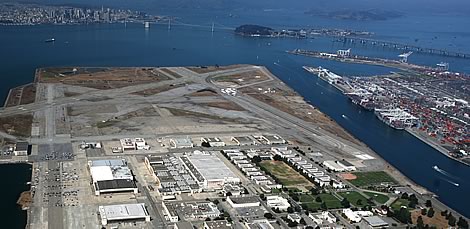Posted April 19, 2010
This is a story of a small urban California island community of 72,000 that turned back a multi-billion dollar global Wall Street hedge fund and their developer front company SunCal from a massive takeover of 700 acres of a contaminated landfill former naval air base in the San Francisco Bay.

At issue was an initiative which the hedge fund and the developer placed before the voter to enable the rollback of a charter amendment limiting growth. Traffic is a big issue in Alameda as it is an island with 4 draw-bridges and one 4-lane underwater tunnel. The plan was to build 4500 housing units without any plan to provide for an increase in traffic.
When the vote took place those voting rejected the plan – 13,000 to 2,000. Citizens signing on to the petitions – all 9,000 changed their minds when it came to election day. How did the opposition score such a resounding defeat against a multibillion dollar hedge fund?
The campaign began 14 months before the vote with weekend potluck brunches. All were welcome and as the weeks progressed information fliers were developed and distributed by friends and neighbors. Letters filled the local newspapers explaining the greedy initiative. Several techies played a valuable role by uncovering the hidden legal language buried in the related documents. Opposition teams walked and talked, spreading the truth of the monster plan. Feedback provided information on how the plan was being understood by the local citizenry. While the developer was mailing out fancy propaganda of empty promises, walkers were on hand to explain the lies and distortions. In the end the NO campaign spent close to $50,000 while the developers spent more than $1.2 million.
At the center of the toxic plan was a stripping of the city of much of its control over the land for over 25 years, bypassing the usual planning department and most importantly the voice of the citizens. Transparency was not guaranteed.
In May the developer did not file the signatures as intended a clue they needed more time to convince voters to accept the plan. However the filing deadline, the end of September, afforded opposition to grow with the county labor council and the chamber of commerce signing on as well. The day before the election, the developer issued a letter to the press admitting their knowledge of pending defeat.
At the center of the controversy is the future of the former military base. There is a growing recognition that the best solution is an adaptive reuse plan. Just last year leases generated more than $17 million. As a brownfield superfund site it is far from being fully contaminate free. Sitting on the east side of the San Francisco Bay it lends itself to an open recreational use, bike paths and site-seeing areas. It is all landfill on previous marshland and in an earthquake region — not the best location for human habitation. Continued adaptive reuse of the existing structures on the base and open space makes the best sense for this land at this time.
What lessons can be drawn from the success in beating back the land-grab in Alameda?
First, that people power can beat money.
Second, the overwhelming vote against the global hedge fund and its developer front, was undoubtedly influenced by the widespread resentment among citizens at the blatant way big money has taken over American politics and rewarded the rich and greedy Wall Street speculators and banks with a trillion dollar bailout while leaving homes to be foreclosed and jobless workers without employment.
The opposition crossed party lines — the local Democratic Party machine was unable to rally support for its developer friends. (When it was said that the Hedge Fund had contributed generously to Obama, people just looked the other way.) Even the Democratic Mayor who had started out supporting the developer switched sides at the end — recognizing that to do otherwise would have harmed her political career.
A small victory in a tiny city, but a sign of subterranean discontent in Main Street America — one that a new social movement and a new party could mobilize as discontent with rising unemployment and homelessness grows and the endless bi-partisan war in the Middle East spreads exhausting the American economy. From a tiny seed in one small island city where the citizens fought back against a Goliath of Wall Street to a new social and political movement.
That’s the hope that Alameda has rekindled. If it could happen here, it can happen throughout America.
Gretchen Lipow, Co-chair, Alameda Public Affairs Forum.

Comments
One response to “Main Street Beats Wall Street”
Great article! But now we must focus on how this valuable land will be used. There are still competing forces. I hope this land will be left open and undeveloped. The endangered California Least Tern uses this land as there home. People need open space for peace of mind. This was once a marshland and was filled in with dirt. Let nature have it back. It is too valuable for development.